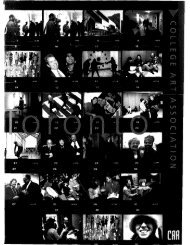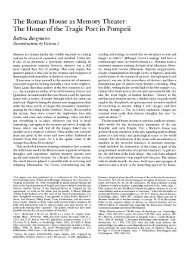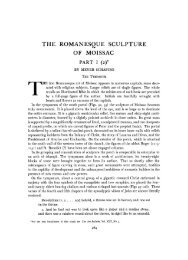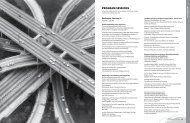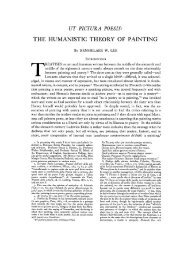Forms of Respect: Alois Riegl's Concept of Attentiveness
Forms of Respect: Alois Riegl's Concept of Attentiveness
Forms of Respect: Alois Riegl's Concept of Attentiveness
Create successful ePaper yourself
Turn your PDF publications into a flip-book with our unique Google optimized e-Paper software.
294 THE ART BULLETIN JUNE 1989 VOLUME LXXI NUMBER 2<br />
teenth-century thinker, he turned to perceptual psychology<br />
to combat relativism. Although perception could not place<br />
one in definitive contact with a knowable world, percep-<br />
tion itself was thought to be universal, and hence capable<br />
<strong>of</strong> determining relationships within human society and be-<br />
tween the individual and the world.73 The perceptual the-<br />
ory he subscribed to associated "objective reality" (and the<br />
belief therein) with palpability, and "subjectivity" with op-<br />
ticality. The sense <strong>of</strong> touch isolated objects in order to val-<br />
idate their separate material existence.74 This in turn vali-<br />
dated the subjective "optical" relationships into which the<br />
visual sense can unite them. <strong>Riegl's</strong> system <strong>of</strong> formal anal-<br />
ysis grew out <strong>of</strong> this pursuit. He sought to validate artistic<br />
images by tracing their formal attributes to the optical and<br />
tactile senses. If the viewer could be convinced that he could<br />
touch an object, he would believe in its reality, and hence<br />
its ability to enter into a(n optical) relationship.<br />
In the formal language <strong>of</strong> Spiitrbmische Kunstindustrie,<br />
the work <strong>of</strong> art mirrors the relationships that a culture<br />
wishes to see in the world.75 The ancients, according to<br />
Riegl, utilized references to "tactile" qualities in order to<br />
assure themselves <strong>of</strong> the material reality <strong>of</strong> the objects they<br />
depicted. Later cultures united these objects optically. Thus<br />
formal signs <strong>of</strong> perception, not naturalistic representation,<br />
became markers <strong>of</strong> artistic validity, or the reference <strong>of</strong> art<br />
to something outside <strong>of</strong> itself. Not surprisingly, Riegl wor-<br />
ried about the contemporary preponderance <strong>of</strong> artistic op-<br />
ticality, and repeatedly looked for indications that the pal-<br />
pable element would reemerge.76<br />
The project had consequences for the conception <strong>of</strong> the<br />
work <strong>of</strong> art as a unified whole. For a work that was to<br />
illustrate relationships, perfect unity was undesirable; hence<br />
<strong>Riegl's</strong> attention, in Spiitr6mische Kunstindustrie, to the<br />
isolation <strong>of</strong> parts from one another and in the plane. Riegl<br />
did not regard this separation, secured by the sense <strong>of</strong><br />
touch, as limited to late Roman art, however. All art, he<br />
wrote, is a "matter <strong>of</strong> coming to terms between the subject<br />
on the one hand and the thing (i.e., extension, space) on<br />
the other hand, and by no means a full dissolution <strong>of</strong> the<br />
object in the subject, which would absolutely mean the end<br />
<strong>of</strong> the fine arts." Even though moderns might emphasize<br />
color over the "character <strong>of</strong> palpability," the object exists<br />
and cannot be disregarded completely in favor <strong>of</strong> the<br />
attribute.77<br />
73 Some <strong>of</strong> those who followed this line <strong>of</strong> thinking were neo-Kantians,<br />
notably Friedrich Lange. But other thinkers concerned with the problem<br />
<strong>of</strong> relativism passed through a perceptual-psychological stage, including<br />
<strong>Riegl's</strong> teachers Franz Brentano and Alexius Meinong.<br />
74 The association <strong>of</strong> the sense <strong>of</strong> touch with the notion <strong>of</strong> verification<br />
has an extensive history. For a brief discussion <strong>of</strong> this history, see my<br />
article "Verification by Touch in Kandinsky's Early Abstract Art," Critical<br />
Inquiry, forthcoming, 1989.<br />
75 Passages such as the following, however, do suggest the use <strong>of</strong> art to<br />
regulate relationships perceptually: "Alles Wollen des Menschen ist auf<br />
die befriedigende Gestaltung seines Verhiltnisses zu der Welt (im umfas-<br />
sendsten Sinne des Wortes, inner- und auperhalb des Menschen) gerichtet.<br />
Das bildende Kunstwollen regelt das Verhiltnis des Menschen zur sinnlich<br />
wahrnehmbaren Erscheinung der Dinge"; Riegl, 1901/1927, 401.<br />
The theory <strong>of</strong> attention is due to the same desire to give<br />
humanity a common basis on which to communicate, in<br />
the recognition <strong>of</strong> the reality - difference, separation -<br />
<strong>of</strong> the external world. As the passage just cited illustrates,<br />
the language <strong>of</strong> touch and sight continues in Das holliin-<br />
dische Gruppenportriit. But perceptual metaphors play only<br />
a supporting role here. Art does not depict a relationship<br />
in this drama, but rather performs it with the beholder.<br />
This approach to art seems to want to liberate art from<br />
signs, giving art the look <strong>of</strong> a natural mode <strong>of</strong> communi-<br />
cation. Even if not palpably "real," an object convincingly<br />
acts out its relationship to a beholder if it pays attention<br />
to that beholder, and acknowledges its own existence as a<br />
subject. The theory <strong>of</strong> attention, then, can be seen as an<br />
attempt to preserve communication while circumventing<br />
the issue <strong>of</strong> representation.<br />
The presence <strong>of</strong> a hermeneutical element in this theory<br />
is corroborated by <strong>Riegl's</strong> historical practice, which, as<br />
mentioned above, made use <strong>of</strong> a dialogue with the present<br />
to identify the distinguishing element in the past. Indeed,<br />
he used a perceptual metaphor to describe the attitude <strong>of</strong><br />
his contemporaries toward the material remains <strong>of</strong> the past.<br />
Their "value for history," which grasped individual events,<br />
was "as though objectively palpable." Like respect for the<br />
object, Riegl thought he saw the value for history being<br />
submerged in a more subjective relation to the past. The<br />
"value for age" (Alterswert) subsumed the object in the sub-<br />
ject to produce "moods" (Stimmungen).78 In his view, the<br />
scholar's establishment <strong>of</strong> the otherness <strong>of</strong> the past pre-<br />
pared the way for the more subjective value, but was also<br />
in conflict with it. Riegl compared the modern historian to<br />
the philosophers <strong>of</strong> late antiquity, who, as intellectuals, in-<br />
troduced the teachings later popularized - and emotion-<br />
alized - by Christianity.79<br />
Thus <strong>Riegl's</strong> formal aesthetics, like his "theatrical" aes-<br />
thetics, grew out <strong>of</strong> a critique <strong>of</strong> society. He feared that<br />
modern man had lost contact with the external facts <strong>of</strong> the<br />
world and with his fellow man. Riegl sought not only to<br />
arouse interest in painters <strong>of</strong> the past who respected the<br />
role <strong>of</strong> art in facilitating human communication, but, at a<br />
deeper level, to address the problem at the heart <strong>of</strong> modern<br />
man's excessive subjectivity. As Riegl saw it, man had lost<br />
confidence in the shared, communicable "reality" <strong>of</strong> the<br />
visible world, including the ability <strong>of</strong> art to represent.<br />
76 For example, the following passage <strong>of</strong> 1904: "Ich bin auch iiberzeugt,<br />
dap die Kunst selbst vor dem Aupersten haltmachen wird, und Symptome<br />
dafuir sind jetzt schon zu bemerken. Denn soll das zu fillig sein, daI gerade<br />
ein Kiinstler wie Toorop, dem sich mehr als allen anderen das darzustel-<br />
lende Ding rein zu einem Stimmungsmittel verfliichtigt, diesen Dingen<br />
iupere Formen verleiht, deren Vorbilder aus der altigyptischen Kunst ges-<br />
ch6pft sind, d. h. aus der Kunst, die ... den nackten taktischen Objek-<br />
tivismus vertreten hat"; Riegl, 1929, 205-206.<br />
77 Riegl, 1902/1931, 189, n. 1.<br />
'8 Riegl, 1929, 169-170.<br />
79 Ibid., 165. For a more detailed discussion <strong>of</strong> the essay in which Riegl<br />
discusses the historical value, see Olin, "The Cult <strong>of</strong> Monuments as a State<br />
Religion in Late 19th Century Austria," Wiener Jahrbuch fiir Kunst-<br />
geschichte, xxxviii, 1985, 177-198; also Forster (as in n. 4).



